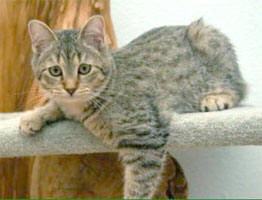
 |
|||||
|
|
 |
|
||||||
Pixie-Bob :: Cat BreedsSometimes called a "Bobcat look-alike", also known as "a dog in disguise", there are Legends in all areas of the continent that suggest the Pixie-Bob's family tree took root when domestic cats imported from Europe met their wild cousins in North America, but its true origin is unknown.  There
is much controversy over the actual history of the breed, due to this the
history is not covered here. There
is much controversy over the actual history of the breed, due to this the
history is not covered here.The breed is rather unique in its ability to capture the hearts of many people who had never before thought of themselves as cat lovers. It has been called the canine of cats both because it is a loyal family member that trains to walk on a leash (if you start early) and because it travels so well in a car. The Pixie-Bob has developed a reputation for being an over-sized cat, especially among the males. However, most breeders consider it a medium-large feline. Certainly, there are numerous examples of mixed breed cats and other breeds which will match its weight. However, this is a heavily muscled breed with heavy boning and it often looks larger than it is. Males are generally 15-20 pounds (some, but not all, reach 25 pounds) while females are about a third smaller, generally 8-15 pounds. The short to medium-long coat of the Pixie-Bob is heavily ticked (agouti) and they are only accepted for show as Brown Spotted Tabby. The breed standard looks for a random spotted or broken mackeral pattern. It has a naturally bobbed tail, usually between two and 6 inches. Being polydactyl is such a dominant trait that this is the only breed accepted for show with more than the usual number of toes. Many Pixie-Bobs also have Lynx tufting on their ear tips. As a breed, Pixie-Bobs are renowned for their quiet nature. Many will rarely call out and they tend, instead, to voice what they want with musical chirrups. This is not to say they don't communicate a lot. however, the Pixie-Bob has a unique way of gesturing with a raised paw as if to emphasize some point they are delivering through a mind-meld. Pixie-Bobs are affectionate and gregarious cats, but you would not call these highly independant beings lap cats. They would rather be with you on their own terms and tend to sit beside you. While some are cuddlers, most will resist being picked up and carried. The family bond of this breed is so strong that they do not easily transfer owners after the age of one or two years. Still, they are gregarious and friendly, even tending to run to the door to welcome visitors to their home. They get along well with children and they also live comfortably with dogs and other pets. In fact, breeders speak of Pixie piles because these cats love to curl up beside and drape themselves over their companions. Polydactyl (many toed) paws are a common occurrence in the breed, and these larger paws add to the breed's wild look, but do not hinder it's ability to get around. Personality Traits:
Care and needs:
Related Articles: |
|||||||
| © 2006-2025 AnimalPets.org. Page generation 0.004 seconds. |